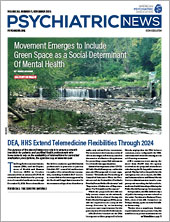The veterinary tranquilizer xylazine is increasingly present in illicit fentanyl and presents several unique clinical challenges that health professionals must be prepared to address. In his keynote address at the Johns Hopkins University’s Road to Recovery virtual conference in September, Ashish Thakrar, M.D., M.S., discussed these challenges and presented an overview of the emerging threat of fentanyl mixed with xylazine.
Xylazine is an alpha-2 receptor agonist that decreases sympathetic activity, resulting in sedation, analgesia, and euphoria, explained Thakrar, who is an assistant professor of medicine in the Division of General Internal Medicine at the University of Pennsylvania.
Thakrar said that one of the main challenges with xylazine is that people who overdose on fentanyl or other opioids mixed with xylazine do not respond as well to resuscitation with naloxone as those who overdose on opioids alone. Yet naloxone should always be administered in cases of a suspected overdose, he added.
“The key thing to remember is that naloxone will reverse the effects of any opioids [in a person who overdoses], so administering naloxone is the most important thing we can do for someone who is experiencing overdose,” he said. Thakrar presented data showing that overdose deaths involving fentanyl with xylazine detected are concentrated in several hotspots in the mid-Atlantic and northeastern regions—notably Baltimore, Connecticut, Philadelphia, and Vermont. He noted that there are signs that these overdose deaths are increasing in other states as well. To that end, Thakrar emphasized the importance of testing substances for xylazine as a harm reduction measure, adding that test strips specifically for xylazine are now on the market.
“They don’t require a lot of prep and there’s very little training required, so you can use them at the point of care and distribute them out to people who use drugs or harm reduction organizations or clinicians,” Thakrar said. The strips are able to measure xylazine levels as low as 2 micrograms per milliliter, he continued; however, lidocaine, diphenhydramine, and levamisole can all give a false positive.
Thakrar explained that because xylazine is an alpha-2 agonist, it would stand to reason that xylazine would have withdrawal symptoms similar to withdrawal from clonidine or dexmedetomidine, but there is no firm evidence for a distinct xylazine withdrawal syndrome. He described a study at the University of Pennsylvania where researchers reviewed 74 hospitalized patients whose urine tested positive for xylazine.
“We did see these reports of anxiety and restlessness, but then we did a chart review … to see if we could find evidence of withdrawal unique to xylazine, and by and large, that’s not [what we found],” Thakrar said. Instead, in most cases the symptoms of withdrawal were that of withdrawal from mixed opioids and benzodiazepines that the patients had used. “We only found two patients who had symptoms that we could not explain, and they had asymptomatic hypertension with or without tachycardia.”
Xylazine use can lead to soft tissue wounds, but these wounds are different from those typically associated with intravenous drug use, Thakrar said. First, the wounds often occur far from the injection site, and they have been known to occur in people who do not inject substances. Second, the wounds have a different appearance and progression, starting with purple blisters or ulcers that coalesce into deep eschar (dry, blackened, dead tissue), often without infection.
Thakrar explained that the association between xylazine use and these wounds is unclear, but that it is possible that xylazine damages endothelial cells, which in turn damages blood vessels. Traditional wound care, such as cleaning and debriding the wound, applying topicals such as skin protectants and antibiotics, and applying two layers of dressing have been found to aid healing in people with soft tissue wounds from xylazine use.
“With the right kind of wound care, and consistent wound care, these wounds do have potential to heal,” Thakrar said. The challenge is that it can be difficult for people who have chaotic or inconsistent substance use or who are homeless to access and maintain wound care, he added. ■

